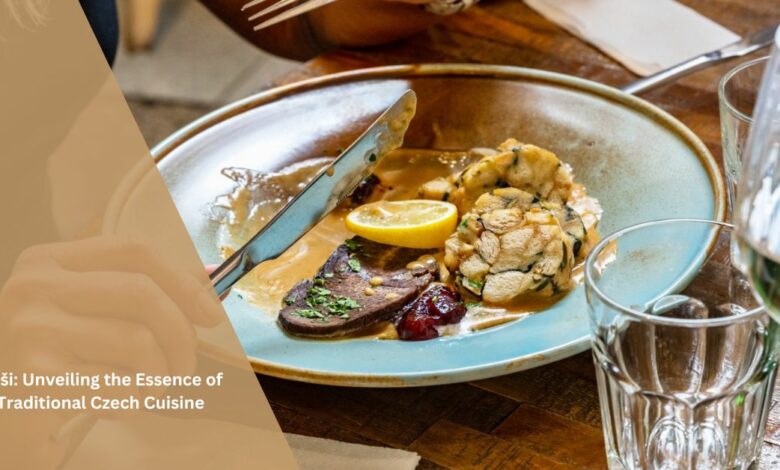Búši: Unveiling the Essence of Traditional Czech Cuisine

When it comes to Czech cuisine, one cannot overlook the rich tapestry of flavors and culinary heritage that defines it.
Among the myriad of dishes that grace Czech dining tables, one stands out prominently for its cultural significance and delectable taste – búši.
In this article, we delve deep into the essence of búši, exploring its history, ingredients, preparation, and the role it plays in Czech gastronomy.
Unraveling the Origins of Búši:
Búši traces its roots back to the heart of Czech culture, where it has been cherished for generations. The word “búši” itself carries a sense of tradition and nostalgia, evoking images of cozy kitchens and family gatherings.
Derived from the Czech word “bůček,” meaning pork belly, búši encapsulates the essence of hearty, rustic cuisine.
Ingredients That Define Búši:
At the core of any búši recipe lies the star ingredient – pork belly. This flavorful cut of meat, with its perfect balance of fat and meat, forms the foundation of búši’s distinct taste and texture.
To enhance the flavor profile, búši often incorporates a medley of aromatic spices such as garlic, caraway seeds, and marjoram.
The Art of Búši Preparation:
Preparing búši is an art form in itself, requiring patience, skill, and a deep understanding of traditional Czech cooking techniques.
The pork belly is meticulously seasoned, then slowly roasted or braised to perfection, allowing the flavors to meld together harmoniously. The result is a tender, succulent dish that melts in your mouth with every bite.
Serving Búši: A Culinary Experience
When it comes to serving búši, simplicity reigns supreme. This humble yet flavorful dish is often accompanied by traditional Czech side dishes such as knedlíky (dumplings), sauerkraut, or potato salad. The combination of textures and flavors creates a symphony of taste that delights the senses.
Búši: A Symbol of Czech Culinary Heritage
Beyond its culinary prowess, búši holds a special place in the hearts of Czech people as a symbol of cultural identity and heritage. It serves as a reminder of simpler times, when meals were prepared with love and shared among family and friends.
In today’s fast-paced world, búši stands as a testament to the enduring traditions that bind communities together.
Preserving the Legacy of Búši:
As we celebrate the culinary delights of búši, it is essential to recognize the importance of preserving this treasured tradition for future generations.
Through continued appreciation and exploration of Czech cuisine, we ensure that the legacy of búši lives on, enriching our lives with its timeless flavors and cultural significance.
Exploring the Regional Variations of Búši:
While búši is celebrated as a quintessential Czech dish, it’s worth noting that there are regional variations that add to its charm and diversity. In different parts of the Czech Republic, you may encounter unique twists on the classic búši recipe, incorporating local ingredients and culinary traditions.
For example, in the Moravian region, búši might be prepared with a slightly different spice blend or served with regional specialties like Moravian wine sauerkraut.
These regional nuances not only showcase the culinary diversity of Czech cuisine but also highlight the deep connection between food and place.
The Role of Búši in Czech Festivities and Celebrations:
In Czech culture, food plays a central role in festivities and celebrations, and búši is no exception. Whether it’s a wedding, a holiday gathering, or a village festival, búši often takes center stage on the dining table, symbolizing abundance, hospitality, and community spirit.
The aroma of slow-roasting pork belly fills the air, drawing people together to share in the joy of good food and good company. In this way, búši not only satisfies hunger but also fosters a sense of belonging and togetherness among Czech people.
Búši: A Culinary Ambassador of Czech Cuisine
As Czech cuisine gains recognition on the global stage, búši emerges as a culinary ambassador, introducing the world to the rich flavors and traditions of Czech cooking.
With the rise of food tourism and international culinary events, more people are discovering the allure of búši and incorporating it into their culinary repertoire.
From trendy Prague restaurants to quaint countryside taverns, búši continues to captivate diners with its irresistible charm and soul-satisfying taste, earning its place as a beloved icon of Czech gastronomy.
The Future of Búši: Innovation and Adaptation
While búši remains deeply rooted in tradition, its future also holds exciting possibilities for innovation and adaptation. Chefs and home cooks alike are experimenting with new techniques, ingredients, and flavor combinations to put a modern twist on this classic dish.
Whether it’s a fusion-inspired búši taco or a gourmet búši burger, the essence of búši continues to inspire culinary creativity and exploration.
As we look ahead, búši remains a beacon of culinary excellence, inviting us to embrace tradition while embracing the evolving tastes of the modern world.
Cultural Significance of Búši: Beyond the Dinner Table
Beyond its role as a delicious meal, búši holds deep cultural significance within Czech society. It is not merely a dish but a symbol of Czech identity, resilience, and the enduring spirit of the Czech people.
Throughout history, Czechs have faced numerous challenges, from political upheaval to foreign occupation, yet their culinary traditions, including búši, have remained a source of comfort and connection to their heritage.
As such, búši serves as a tangible link to the past, preserving the memories and traditions of generations past for future ones to cherish.
Búši: A Culinary Tradition Passed Down Through Generations
One of the most beautiful aspects of búši is its role in fostering intergenerational bonds and passing down culinary traditions from one generation to the next.
Many Czech families have cherished recipes for búši that have been handed down through the ages, each generation adding its own touch while preserving the essence of the dish.
From grandmother to mother to daughter, the art of preparing búši is shared and celebrated, creating lasting memories and reinforcing family ties.
In this way, búši becomes more than just a meal; it becomes a living legacy, connecting past, present, and future.
Búši in the Modern Culinary Landscape: Sustainability and Conscious Eating
In today’s culinary landscape, there is a growing emphasis on sustainability, ethical sourcing, and conscious eating, and búši is no exception. As consumers become more aware of the environmental and ethical implications of their food choices, there is a renewed interest in traditional, locally sourced ingredients like those used in búši.
Many chefs and home cooks are seeking out heritage breeds of pork and supporting small-scale farmers who raise animals in humane and environmentally friendly ways.
By embracing búši and other traditional dishes, we not only honor our culinary heritage but also support sustainable food practices that benefit both people and the planet.
Conclusion:
In conclusion, búši represents more than just a dish; it embodies the soul of Czech cuisine, weaving together flavors, tradition, and heritage into a culinary masterpiece.
Whether enjoyed at a family dinner or savored in a cozy Czech tavern, búši invites us to slow down, savor the moment, and appreciate the simple pleasures of life.
So, the next time you crave a taste of authentic Czech cuisine, remember to indulge in the hearty goodness of búši. Na zdraví! (Cheers!)




